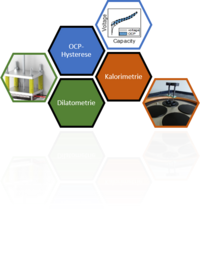AQua – HysKaDi
In the HysKaDi project, next-generation active materials such as silicon for the anode and lithium- and manganese-rich NCMs for the cathode are investigated. These active materials exhibit significant hysteresis at rest potential during cycling in the battery cell, resulting in reduced efficiency and higher thermal load. These phenomena are investigated by calorimetry. In addition, silicon-based anodes show a significant volume expansion during charging, which is analyzed by dilatometry. The aim of the project is to use the generated knowledge to determine the operating limits for an optimized lifetime of cells of this generation. Based on this, the design of a heat management system and the mechanical fixation of the cell will be optimized.
Project partners of the Institute for Electrical Energy Storage Technology in the project HysKaDi are:
- the Chair of Technical Electrochemistry (TEC)
- the Chair of Electrical Energy Systems, University Bayreuth
- the Center for Solar Energy and Hydrogen Research Baden-Württemberg (ZSW)

Acknowledgement
This research project is funded by the Federal Ministry of Education and Research (BMBF), grant number 03XP0321B, and cared by Project Management Jülich.
The project is part of the BMBF Competence Cluster for Analytics/Quality Assurance (AQua).
The responsibility for the content of this publication lies with the author.
| Project members | ||||
|---|---|---|---|---|
| Kunz, Alexander; M.Sc. | +49 (89) 289 - 26975 | alexander.kunz@tum.de | Room: 1015 |
|
